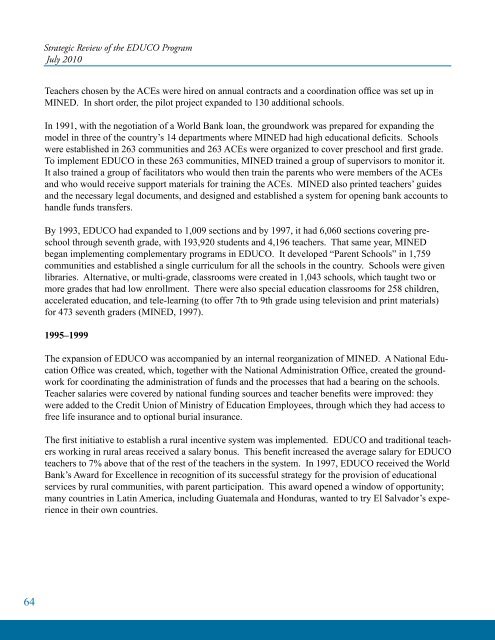<strong>Strategic</strong> <strong>Review</strong> <strong>of</strong> <strong>the</strong> <strong>EDUCO</strong> <strong>Program</strong>July 2010Teachers chosen by <strong>the</strong> ACEs were hired on annual contracts and a coordination <strong>of</strong>fice was set up inMINED. In short order, <strong>the</strong> pilot project expanded to 130 additional schools.In 1991, with <strong>the</strong> negotiation <strong>of</strong> a World Bank loan, <strong>the</strong> groundwork was prepared for expanding <strong>the</strong>model in three <strong>of</strong> <strong>the</strong> country’s 14 departments where MINED had high educational deficits. Schoolswere established in 263 communities and 263 ACEs were organized to cover preschool and first grade.To implement <strong>EDUCO</strong> in <strong>the</strong>se 263 communities, MINED trained a group <strong>of</strong> supervisors to monitor it.It also trained a group <strong>of</strong> facilitators who would <strong>the</strong>n train <strong>the</strong> parents who were members <strong>of</strong> <strong>the</strong> ACEsand who would receive support materials for training <strong>the</strong> ACEs. MINED also printed teachers’ guidesand <strong>the</strong> necessary legal documents, and designed and established a system for opening bank accounts tohandle funds transfers.By 1993, <strong>EDUCO</strong> had expanded to 1,009 sections and by 1997, it had 6,060 sections covering preschoolthrough seventh grade, with 193,920 students and 4,196 teachers. That same year, MINEDbegan implementing complementary programs in <strong>EDUCO</strong>. It developed “Parent Schools” in 1,759communities and established a single curriculum for all <strong>the</strong> schools in <strong>the</strong> country. Schools were givenlibraries. Alternative, or multi-grade, classrooms were created in 1,043 schools, which taught two ormore grades that had low enrollment. There were also special education classrooms for 258 children,accelerated education, and tele-learning (to <strong>of</strong>fer 7th to 9th grade using television and print materials)for 473 seventh graders (MINED, 1997).1995–1999The expansion <strong>of</strong> <strong>EDUCO</strong> was accompanied by an internal reorganization <strong>of</strong> MINED. A National EducationOffice was created, which, toge<strong>the</strong>r with <strong>the</strong> National Administration Office, created <strong>the</strong> groundworkfor coordinating <strong>the</strong> administration <strong>of</strong> funds and <strong>the</strong> processes that had a bearing on <strong>the</strong> schools.Teacher salaries were covered by national funding sources and teacher benefits were improved: <strong>the</strong>ywere added to <strong>the</strong> Credit Union <strong>of</strong> Ministry <strong>of</strong> Education Employees, through which <strong>the</strong>y had access t<strong>of</strong>ree life insurance and to optional burial insurance.The first initiative to establish a rural incentive system was implemented. <strong>EDUCO</strong> and traditional teachersworking in rural areas received a salary bonus. This benefit increased <strong>the</strong> average salary for <strong>EDUCO</strong>teachers to 7% above that <strong>of</strong> <strong>the</strong> rest <strong>of</strong> <strong>the</strong> teachers in <strong>the</strong> system. In 1997, <strong>EDUCO</strong> received <strong>the</strong> WorldBank’s Award for Excellence in recognition <strong>of</strong> its successful strategy for <strong>the</strong> provision <strong>of</strong> educationalservices by rural communities, with parent participation. This award opened a window <strong>of</strong> opportunity;many countries in Latin America, including Guatemala and Honduras, wanted to try El Salvador’s experiencein <strong>the</strong>ir own countries.64
<strong>Strategic</strong> <strong>Review</strong> <strong>of</strong> <strong>the</strong> <strong>EDUCO</strong> <strong>Program</strong>July 20102000–2004In 2000, <strong>EDUCO</strong> continued expanding coverage in preschool and basic education. However, <strong>the</strong> literaturereview showed that <strong>EDUCO</strong> did not continue its rising course, although it did remain as a program,which was important in <strong>of</strong>fering educational opportunities in rural areas. It was not possible to clearlyidentify new contributions regarding policy-setting or modernization <strong>of</strong> <strong>the</strong> system. It appears that attentionwas not paid to <strong>the</strong> administrative issues related to <strong>the</strong> ACEs, pedagogical issues involving studentlearning, or benefits and improved conditions for teachers. The literature shows that <strong>the</strong> <strong>EDUCO</strong> teamswere downsized in MINED, which might have contributed to <strong>the</strong> program’s fragmentation.Likewise, <strong>the</strong> training <strong>of</strong> <strong>the</strong> ACEs, which had been constant during <strong>the</strong> first 10 years, also appears tohave stopped, and <strong>the</strong>re was no training for teachers on issues related to conditions in <strong>the</strong> rural areaswhere <strong>EDUCO</strong> was in place. However, it does seem that one <strong>of</strong> <strong>the</strong> most significant changes during thisperiod was to replace <strong>the</strong> existing supervision system with two different systems: one for pedagogicalassistance and <strong>the</strong> o<strong>the</strong>r for administrative assistance. The first was to provide pedagogical support toschool principals (independent <strong>of</strong> model), with <strong>the</strong> intention <strong>of</strong> <strong>the</strong> principal providing technical guidanceto teachers, and <strong>the</strong> second was for providing administrative support to <strong>the</strong> local school administrationsystems. According to <strong>the</strong> interviewees, this change left <strong>the</strong> ACEs without assistance in <strong>the</strong> area <strong>of</strong>school administration. Technical specialists from <strong>the</strong> Departmental Education Offices had this responsibility;however, <strong>the</strong>re were too few <strong>of</strong> <strong>the</strong>m for <strong>the</strong> number <strong>of</strong> schools <strong>the</strong>y were to serve, as some had tocover over 100 schools.2005–2009In 2005, <strong>EDUCO</strong> went from 11,293 sections to 12,489 sections in one year. MINED created <strong>the</strong> Educationwith Community Participation Division in order to oversee efforts at central and departmentallevels to manage <strong>EDUCO</strong>. During this period, <strong>the</strong> decision was made to focus <strong>EDUCO</strong>’s modernizationand development efforts on human resources. According to <strong>the</strong> literature and opinions <strong>of</strong> interviewees,<strong>the</strong> idea was to streng<strong>the</strong>n <strong>EDUCO</strong> teachers so that <strong>the</strong>y would not be at a disadvantage compared toteachers from <strong>the</strong> regular or Wage Law system. To this end, a career ladder was developed for <strong>EDUCO</strong>teachers so that <strong>the</strong>y could accrue service time and be eligible for category advancement that wouldenable <strong>the</strong>m to receive salary raises every five years, independent <strong>of</strong> <strong>the</strong>ir annual contracts. In addition,<strong>the</strong> payment system for teachers was modernized. Teachers in <strong>the</strong> traditional system were being paidby direct deposit into bank accounts tied to a network <strong>of</strong> automatic teller machines (ATMs). However,<strong>EDUCO</strong> teachers would be paid by checks that were delivered in <strong>the</strong> community and <strong>the</strong>y <strong>of</strong>ten had tomake several attempts to find <strong>the</strong> parents that had to sign <strong>the</strong> checks (ACE president and treasurer). Because<strong>of</strong> this, a direct deposit system was set up that enabled access to <strong>the</strong> money via ATM. In addition,<strong>the</strong> role <strong>of</strong> <strong>the</strong> Processing Agent was created. Most <strong>of</strong> <strong>the</strong>se were accountants, who worked out <strong>of</strong> <strong>the</strong>Departmental Education Offices (one per department) and were responsible for administering <strong>the</strong> fundstransfers and deposits into teachers’ bank accounts.65

















